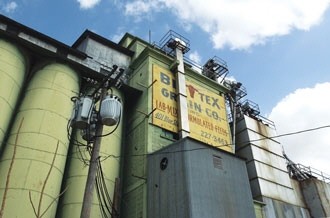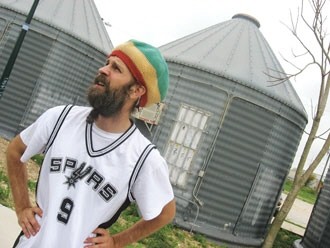| The Big Tex Warehouse on the site where asbestos-contaminated vermiculite was processed. |
(For those with short memories, Lifshutz got the Zoning Commission’s approval to redevelop this King William industrial lot as a mixed-use project last year. It’s on hold due to federal investigations into asbestos contamination on the property. Texas Vermiculite/W.R. Grace & Co. used Big Tex to process 104,000 tons of asbestos-contaminated vermiculite from Libby, Montana, here from 1961 to 1989.)
“From what they said at the management office, they’d close it down and fence it off,” Ras Christopher Frances, 25, said about shuttering the silos, once the crown jewel of Say-Town’s underground arts scene. (Experimental guitarists Warren Rivera and James Sidlo did their minimalist recording in Silo 10; Current photographer Justin Parr once ran Fl!ght Gallery in Silo 18.)
|
Ras Christopher Frances outside his former Blue Star Art Silo |
“They didn’t say why.” Frances stroked a long, wiry beard threaded with grey hair. “My guess: I think that they think if they fence it off it will keep kids from spray-painting along the river … doing throw ups like a dog marking its territory.”
You’d think the Environmental Protection Agency’s empirical science had given its blessings to Big Tex’s environmental fitness already, to hear the artists using its silos and the adjacent warehouse, Studio 357, where furniture is being made.
“This is all I can say about the asbestos issue and the fact that `the` asbestos b.s. has never affected my health,” wrote Raul Castellanos, one of the three artists still using the silos last week, in an email. “I feel healthier than ever. Proof: last night I created 6 paintings with my associate at the silos. The silos is `sic` only guilty of radiating enormous creative vibe.”
But Big Tex got a scuzz-black bill of health after EPA and Texas Commission on Environmental Quality performed soil sampling and air monitoring in July and August 2006 and found concentrated levels of asbestos fibers around the lot’s buildings `“Home soil,” August 23-29, 2006` — the kind that lodge like invisible needles in the lungs’ spongy airways.
Asbestos exposure can cause asbestosis, pleural mesothelioma, and lung cancer, says Senior Toxicologist Keller Thormahlen at the Texas Department of State Health Services. Thormahlen — a blunt East Texan that one City staffer characterizes as a loose cannon — flat out calls Big Tex a hazardous waste site. “The site … should never have been re-zoned mixed-use by the City until the hazardous waste site has been cleaned up,” he says. “You can’t redevelop a hazardous waste site. We already know it’s
contaminated.”
For its part, the EPA sounds more measured. The agency has recently resumed pressuring Big Tex’s owner. John Rinehart, the EPA site-assessment manager handling the property, told the Current the agency has given Lifshutz a deadline of this Friday to agree to perform an extensive grid sampling of the entire property to determine how widespread the asbestos contamination is, or the EPA’ll do it themselves and charge him $100,000. It’s a deadline that may have touched off the moving-day notices from Lifshutz’s rental offices.
“They said that they want to condemn the area and figure out how it’s to be treated,” said Justin Sonnen, owner of San Antonio Superbike, located on the Big Tex property for four years. Sonnen said his leasing agent said a moving date was still up in the air.
In an interview with the Current last week, Stephanie Holly, a leasing agent with Lifshutz’s office, said: “We `have` to close off that whole Big Tex area.”
The artists are right to worry that their special place is gone forever. “It’s environmental stuff,” said Holly when asked if fencing the silos was a response to graffiti or vandalism. “I don’t even know if we can develop it.”
Then the Current got word on Monday that three maintenance workers kicked Frances, the Rasta, out of his Blue Star Silo and padlocked his stencils, spray paint, drums, and computer inside the 250-square-foot corrugated metal grain bin.
That’s “an issue of nonpayment,” said Holly. But she went on to address rumors that all Big Tex tenants would have to leave: “We’re fencing it off and not renting to new renters. We’re not asking anybody to leave, yet … The entire property is going to be fenced off.”
It’s a happy accident that the backburner issue of whether the former Big Tex Grain Co. property at Blue Star is contaminated with asbestos is expected to see some action the same week of the 3rd Annual Asbestos Awareness Day conference, held this weekend at Drexel University College of Medicine in Pennsylvania. Douglas Larkin, co-founder of Asbestos Disease Awareness Organization, a coordinator of the conference, commented on the news EPA had mandated more testing at Big Tex:
“The EPA is great at testing, but where they come up short is making decisions where they fine `people` and take legal action.”
In related news, the City has negotiated with the EPA to continue with its San Antonio River Improvement plans for the adjacent area, known as the Eagleland Hike and Bike.
Jelynne LeBlanc Burley, deputy city manager, said she’s meeting with Lifshutz this week to discuss access routes through his property to develop Eagleland. She insists that the only EPA results on the area have been “no results, except that they need to do more tests.” Rinehart recently gave the City the go ahead to move forward on construction of a very specific part of Eagleland that will not interrupt sampling at Big Tex, Burley said.



